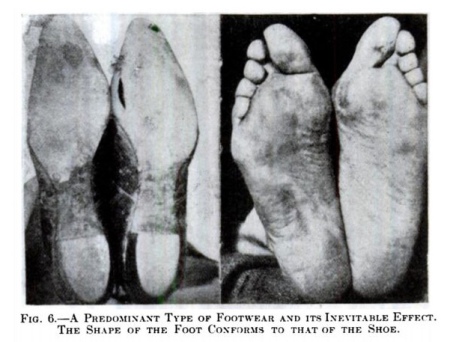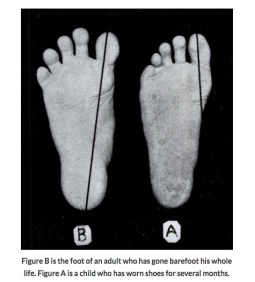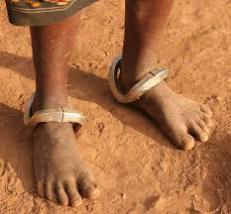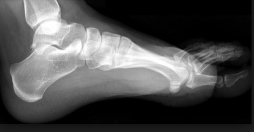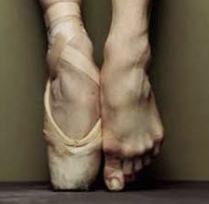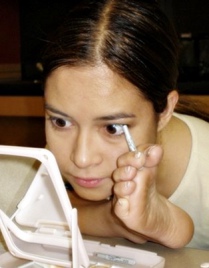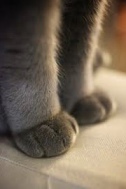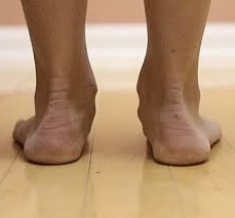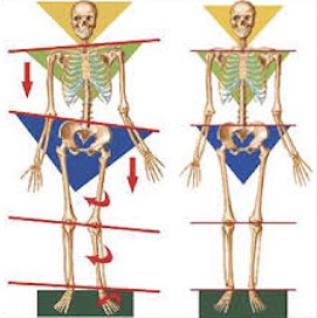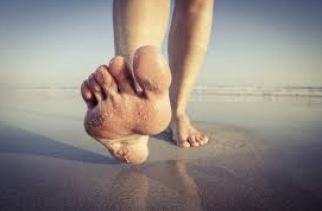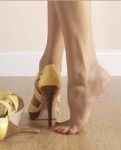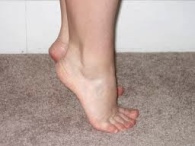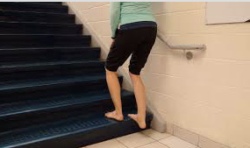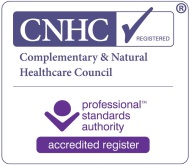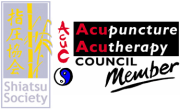Our Feet - probably the most abused and ignored part of our body
Why am I writing this article?
A major part of my work over the last 20 years has been treating painful conditions and their underlying muscular imbalances and bio-mechanical distortions.
In order to achieve long-lasting results from my treatment, most often the activation and strengthening of the neglected and weak muscles needs to be addressed.
Ok, but why the feet now?
Because the feet are the platform of our body and they influence and are influenced by the rest of our body.
The way we treat our feet, with restrictive shoes, supportive insoles and over supportive orthotics, weakens out feet. This not only contributes to foot dys-formations, but affects the whole of our body’s biomechanics.
Our muscular system is used in an integrated and interdependent way, we can not ignore the dysfunction of our feet. So there is not much point of improving the body’s functionality by strengthening the weak core muscles, if the feet are ignored.
So, good posture, efficient biomechanics and a functionally fit body starts in the feet.
That’s why I often say: “Our core start in our feet”
Foot vs Shoe - or the cause of the modern world’s foot problem?
In the modern world, we nearly always wear shoes and we have forgotten about our feet. We love our shoes and wear them to fit the rest of our fashion outfit, but not necessarily our feet and we often hate our feet when they don't fit the shoes we love!
From a very young age, when our feet were still malleable, we put our feet away into feet-unfriendly, misfitting shoes or restrictive boxes, which hinders our feet and toes from moving and expanding, stopping them from being able to feel the ground and grip naturally.
Around half of women and a third of men generally buy shoes that don’t fit properly. Shoes that are too small cause compression that alters the shape of our feet, undermining natural movement and weakening your feet.
Women experience foot problems four times more often than men.
More than half the women in the UK have bunions, a common foot deformity in which the joint that connects the big toe to the foot gets larger and juts out.
Foot problems in the elderly are extremely common and are the cause of much pain and disability, and consequent loss of mobility and independence.
What is a normal foot?
I remember in my twenties when I was travelling and I was often in many poor, developing countries where many people walked barefoot. Feet looked different, strong and well-used, like builders’
hands. Toes were spread wide to grip and to enable propulsion.
Feet there did not look to me like they would fit any conventional shoes!
Our feet are made to work, to carry, support, balance and move us and they need this natural stress in order to be functionally healthy.
If we don't let them do the work from the above reasons, they weaken and often collapse. Other muscles in the foot, lower legs or elsewhere in the body need to then overcompensate and a muscular imbalance or biomechanical distortion is created as a result.
The Human Foot - a Biomechanical masterpiece, millions of years in the making
This genius, complex, supportive structure provides us with tremendous stability, while at the same time gives us flexibility for suspension and three-dimensional movements, as well as sensitivity to feel the ground under our feet.
So briefly, what are our feet made for?
…support
We literally stand on them! This ‘bridge-like’ structure carries our body and allows shock absorption when we walk, run or jump. During every step, we take when walking we apply double our body weight on our feet, when we run it is as much as three times our body weight and much more when we jump.
…strength
Our feet are extremely strong, especially our big toes, which are vital for balancing and propelling us forward. Children don't walk till they develop the necessary strength in their big
toes.
During an average day of walking, the forces on your feet can total hundreds of tons, equivalent to an average of a fully loaded cement truck. There is a lot of stress on our feet, so it is important
to keep our feet strong and healthy.
…flexibility
The human foot contains 26 bones, 33 joints, 107 ligaments, 19 muscles and tendons. 25% of all the bones in the human body are in your feet. This provides us with movement, accommodating the contour of the ground and giving us the possibility to use it as tool, in a similar way to using our hands.
…sensitivity
Like our hands, our feet are the most sensitive part of our body and offer us a fantastic sensory tool. Feet have thousands of neural receptors, giving us sensory information on the ground in which we walk and the position the rest of the body is in, allowing us to enjoy natural movements and balance.
What problems do weakened feet cause?
Although a very small percentage of us are born with foot problems and there are illness and disorders affecting the feet, most of our foot problems are caused my weakness of the foot and the biomechanical distortions in our legs and hips.
The most common collapse in the foot is the over-pronation of the foot, the over-collapse of the foot’s arch or instep.
The over-pronation causes misalignment of the foot that causes stress on the foot’s ligaments and joints, producing inflammation like plantar fasciitis (heel spurs, plantar fasciitis and calluses).
This inward collapse misaligns the big toe and forces too much body weight on the big toe joint in the pushing-off action involved in our next step, which often causes bunions (and calluses).
This over-pronation will not just affect the foot structure itself, but affect the whole musculoskeletal alignment and functionality of the body above.
When walking or running the collapse of the arch of the foot will rotate the leg inward, affecting the alignment of the ankle, knee and hip and forcing your body out of proper alignment.
It causes a misalignment and dysfunction of the muscular skeletal structure above, often causing chronic inflammation like Achilles tendonitis, shin splints, knee and hip pain, etc.
The arch of the foot acts as a shock absorber and over-pronation will pass the shock onto your legs, knees, hips and spine.
Do our feet need extra support when they are weakened?
We are often advised in ‘specialized’ running shops to buy shoes with extra stability, motion control and high arch support.
Or we are told to get some off-the-shelf orthotics or the more expensive version to have some ‘custom-made’ orthotics made for us.
The general intention is to support our feet and prevent excessive pronation.
In my experience, being fitted with supportive shoes or orthotics may indeed correct the over-pronation of the foot and the related complaints, but without the correction of the muscular imbalance, more often than not, it just moves the complaint and pain somewhere else in your body.
The rigid and unforgiving over-support will not strengthen our feet, but makes them further asleep, often causing more stress and injury higher up in the biomechanics chain of the body.
I believe the important question is not ‘IF we are over-pronating’, but asking the question ‘WHY are we over-pronating’.
I personally believe that just propping up the foot without correcting the muscular imbalance in the foot and ankle and the biomechanical chain above is short-sighted.
How can it be corrected?
In my opinion, the most common reason for over-pronation and other foot problems are a gradual bio-mechanical distortion in feet, legs and hips and pelvis, due to muscular imbalances (a shortening and weakening of muscles) in the foot or the legs and hips above.
In order to be specific with recommendations you would have to come for an appointment to have a functional and a structural examination undertaken to evaluate your feet, ankles, hips, pelvis and spine in terms of their alignment and motion, strength and flexibility, stability and balance.
My treatments will help to release your tight, overworked and shortened muscles. Once they regain normal functionality and length, they will allow your weaker and neglected muscles to start working properly again.
Most often, exercise will be given to speed up the process of regaining better muscular balance, more natural movements and posture.
In time your feet will be stronger, you will have increased ankle mobility, improved posture and better balance and a new-found sense of connection with the ground.
We have all forgotten how to move. Moving regularly and uninhibited is key to human health and fitness.
The first step towards happy, healthy movement should start with the toes and feet.
Increase your Foot and Body Awareness:
I strongly believe that small habitual changes will make a big impact. Relatively easy activities can be added to your daily routine without causing much disruption.
Be Barefoot:
Wear appropriate Footwear:
It’s a good start wearing wide, thin-soled and flexible shoes, that don't interrupt the natural movement.
Enjoy your heels, they look great!
But train your feet to stand well and strong in heels and don't wear them too often.
Give your feet a well-earned rest. Why not try wearing barefoot shoes for your commute?
Exercise your feet to strengthen them:
Make a habbit to regularly move your feet and toes, maybe do some toe and foot exercises whilst brushing your teeth.
Walking is the best exercise for your feet. It also contributes to your general health by improving circulation, contributing to weight control, and promoting all-around well-being.
Walk up stairs and escalators without putting your heels down or over-pronating your feet.
When walking think about good posture and correct walking pattern.
Enjoy and appreciate your feet!
Nearest Tube stations
Bond Street, Oxford Street, Baker Street, Regent's Park and Great Portland Street
Appointments
Tuesday 10.00 - 19.00
Thursday 10.00 - 19.00
Call or text Daniel:
+44 07932 671 463

